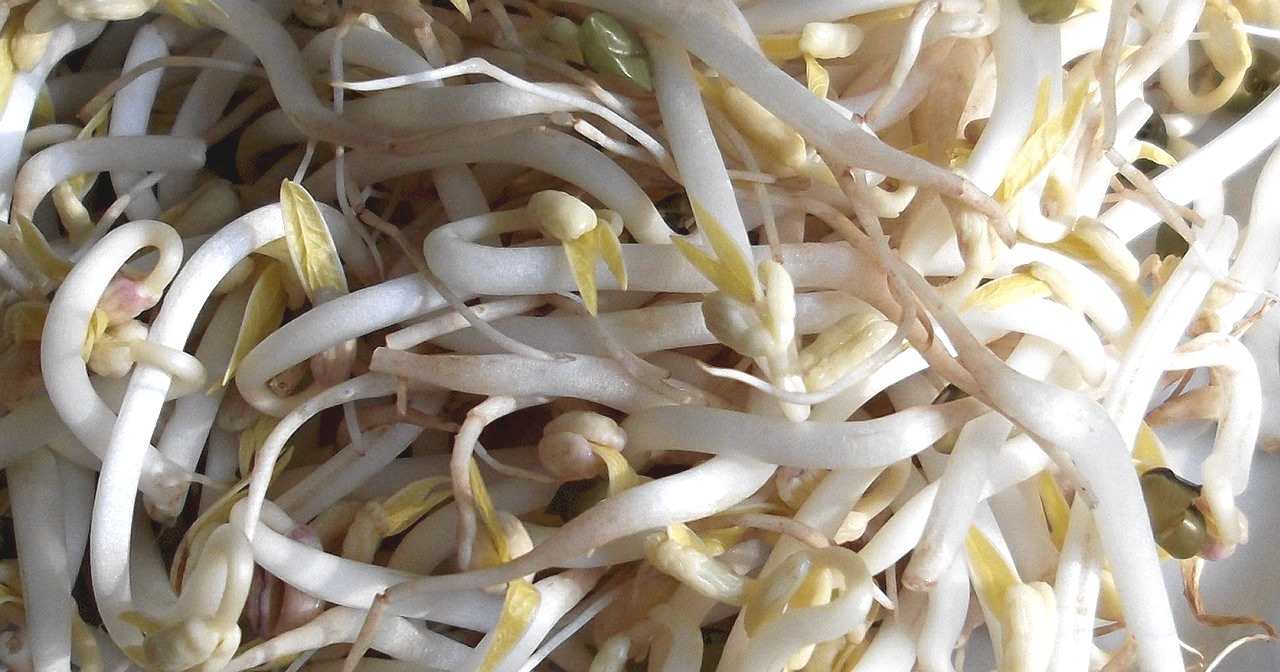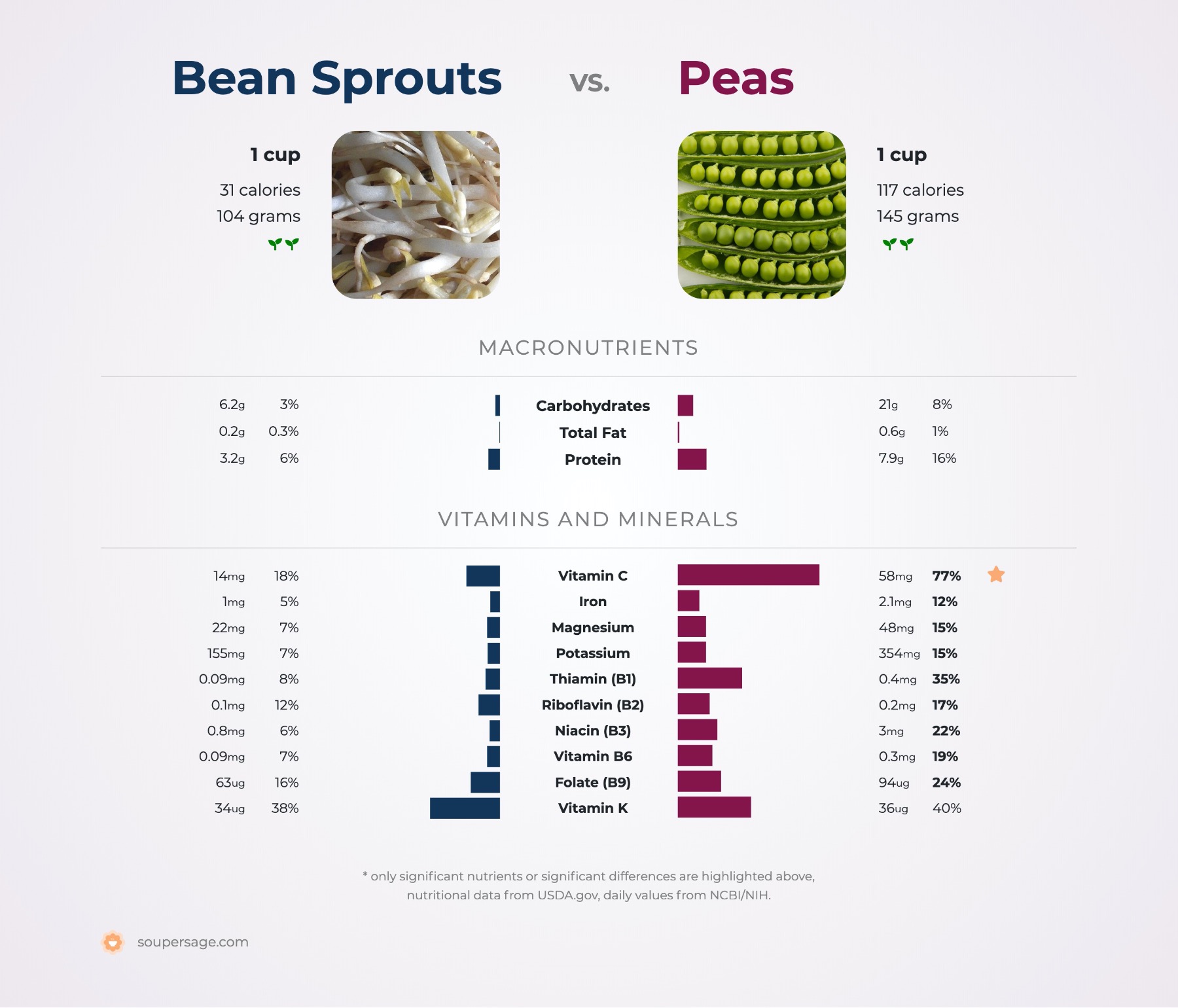Bean Sprouts vs. Peas
Nutrition comparison of Bean Sprouts and Peas
Ever wonder how your favorite foods stack up against each other in terms of nutrition?
We compared the nutritional contents of
bean sprouts
versus
peas
(100g each)
below using 2020 USDA and NIH data[1].
For a quick recap of significant nutrients and differences in bean sprouts and peas:
- Both bean sprouts and peas are high in Vitamin C.
- Bean sprout has 59% less carbohydrates than pea.
- Bean sprout has 63% less calories than pea.
- Pea has more thiamin and niacin, however, bean sprout contains more pantothenic acid.
- Pea is a great source of potassium.
- Pea is an excellent source of dietary fiber.
USDA sources for nutritional information: Bean Sprouts (Mung beans, mature seeds, sprouted, raw) and Peas (Peas, green, raw) . Have a correction or suggestions? Shoot us an email.
Calories and Carbs
calories
Bean sprout has 63% less calories than pea - bean sprout has 30 calories per 100 grams and pea has 81 calories.
For macronutrient ratios, bean sprouts is heavier in protein, lighter in carbs and similar to peas for fat. Bean sprouts has a macronutrient ratio of 32:63:5 and for peas, 26:70:4 for protein, carbohydrates and fat from calories.
Macro Ratios from Calories:
| Bean Sprouts | Peas | |
|---|---|---|
| Protein | 32% | 26% |
| Carbohydrates | 63% | 70% |
| Fat | 5% | 4% |
| Alcohol | ~ | ~ |
carbohydrates
Bean sprout has 59% less carbohydrates than pea - bean sprout has 5.9g of total carbs per 100 grams and pea has 14.5g of carbohydrates.
dietary fiber
Pea is an excellent source of dietary fiber and it has 217% more dietary fiber than bean sprout - bean sprout has 1.8g of dietary fiber per 100 grams and pea has 5.7g of dietary fiber.
sugar
Bean sprouts and peas contain similar amounts of sugar - bean sprout has 4.1g of sugar per 100 grams and pea has 5.7g of sugar.
Protein
protein
Pea has 78% more protein than bean sprout - bean sprout has 3g of protein per 100 grams and pea has 5.4g of protein.
Fat
saturated fat
Both bean sprouts and peas are low in saturated fat - bean sprout has 0.05g of saturated fat per 100 grams and pea has 0.07g of saturated fat.
Vitamins
Vitamin C
Both bean sprouts and peas are high in Vitamin C. Pea has 203% more Vitamin C than bean sprout - bean sprout has 13.2mg of Vitamin C per 100 grams and pea has 40mg of Vitamin C.
Vitamin A
Pea has 37 times more Vitamin A than bean sprout - bean sprout has 1ug of Vitamin A per 100 grams and pea has 38ug of Vitamin A.
Vitamin E
Bean sprouts and peas contain similar amounts of Vitamin E - bean sprout has 0.1mg of Vitamin E per 100 grams and pea has 0.13mg of Vitamin E.
Vitamin K
Bean sprouts and peas contain similar amounts of Vitamin K - bean sprout has 33ug of Vitamin K per 100 grams and pea has 24.8ug of Vitamin K.
The B Vitamins
Pea has more thiamin and niacin, however, bean sprout contains more pantothenic acid. Both bean sprouts and peas contain significant amounts of riboflavin, Vitamin B6 and folate.
| Bean Sprouts | Peas | |
|---|---|---|
| Thiamin | 0.084 MG | 0.266 MG |
| Riboflavin | 0.124 MG | 0.132 MG |
| Niacin | 0.749 MG | 2.09 MG |
| Pantothenic acid | 0.38 MG | 0.104 MG |
| Vitamin B6 | 0.088 MG | 0.169 MG |
| Folate | 61 UG | 65 UG |
Minerals
calcium
Pea has 92% more calcium than bean sprout - bean sprout has 13mg of calcium per 100 grams and pea has 25mg of calcium.
iron
Pea has 62% more iron than bean sprout - bean sprout has 0.91mg of iron per 100 grams and pea has 1.5mg of iron.
potassium
Pea is a great source of potassium and it has 64% more potassium than bean sprout - bean sprout has 149mg of potassium per 100 grams and pea has 244mg of potassium.
Antioxidants and Phytonutrients
carotenoids
Carotenoids are micronutrients commonly found in plants and some animal products. An example is beta-carotene, the notable carotenoid which is a popular source of Vitamin A.[4][5]
For specific types of carotenoids,
| Bean Sprouts | Peas | |
|---|---|---|
| beta-carotene | 6 UG | 449 UG |
| alpha-carotene | 6 UG | 21 UG |
| lutein + zeaxanthin | ~ | 2477 UG |
Omega-3 and Omega-6
omega 3s
For omega-3 fatty acids, pea has more alpha linoleic acid (ALA) than bean sprout per 100 grams.
| Bean Sprouts | Peas | |
|---|---|---|
| alpha linoleic acid | 0.016 G | 0.035 G |
| Total | 0.016 G | 0.035 G |
omega 6s
Comparing omega-6 fatty acids, pea has more linoleic acid than bean sprout per 100 grams.
| Bean Sprouts | Peas | |
|---|---|---|
| linoleic acid | 0.042 G | 0.152 G |
| Total | 0.042 G | 0.152 G |
Customize your serving size
The comparison below is by weight, but sometimes 100g isn't that intuitive of a measurement for food. View a custom portion comparison (e.g. cups, oz, package).
You can try adding or subtracting the amount of either Bean Sprouts or Peas .
Note: The specific food items compared are: Bean Sprouts (Mung beans, mature seeds, sprouted, raw) and Peas (Peas, green, raw) .
Bean Sprouts g
()
|
Daily Values (%) |
Peas g
()
|
|||||
|---|---|---|---|---|---|---|---|
| KCAL % |
|
5% | calories | 5% |
|
KCAL % | |
| G % |
|
5% | carbohydrates | 5% |
|
G % | |
| G % |
|
5% | dietary fiber | 5% |
|
G % | |
| G | 5% | sugar | 5% | G | |||
| G % |
|
5% | total fat | 5% |
|
G % | |
| G % |
|
5% | saturated fat | 5% |
|
G % | |
| G | 5% | monounsaturated fat | 5% | G | |||
| G | 5% | polyunsaturated fat | 5% | G | |||
| G | 5% | trans fat | 5% | G | |||
| MG | 5% | cholesterol | 5% | MG | |||
| MG % |
|
5% | sodium | 5% |
|
MG % | |
| 5% | Vitamins and Minerals | 5% | |||||
| UG % |
|
5% | Vitamin A | 5% |
|
UG % | |
| MG % |
|
5% | Vitamin C | 5% |
|
MG % | |
| IU % |
|
5% | Vitamin D | 5% |
|
IU % | |
| MG % |
|
5% | calcium | 5% |
|
MG % | |
| MG % |
|
5% | iron | 5% |
|
MG % | |
| MG % |
|
5% | magnesium | 5% |
|
MG % | |
| MG % |
|
5% | potassium | 5% |
|
MG % | |
| MG % |
|
5% | thiamin (Vit B1) | 5% |
|
MG % | |
| MG % |
|
5% | riboflavin (Vit B2) | 5% |
|
MG % | |
| MG % |
|
5% | niacin (Vit B3) | 5% |
|
MG % | |
| MG % |
|
5% | Vitamin B6 | 5% |
|
MG % | |
| MG % |
|
5% | pantothenic acid (Vit B5) | 5% |
|
MG % | |
| UG % |
|
5% | folate (Vit B9) | 5% |
|
UG % | |
| UG % |
|
5% | Vitamin B12 | 5% |
|
UG % | |
| MG % |
|
5% | Vitamin E | 5% |
|
MG % | |
| UG % |
|
5% | Vitamin K | 5% |
|
UG % | |
| G % |
|
5% | protein | 5% |
|
G % | |
| UG % |
|
5% | biotin (Vit B7) | 5% |
|
UG % | |
| MG % |
|
5% | choline | 5% |
|
MG % | |
| MG % |
|
5% | chlorine | 5% |
|
MG % | |
| UG % |
|
5% | chromium | 5% |
|
UG % | |
| MG % |
|
5% | copper | 5% |
|
MG % | |
| UG % |
|
5% | fluoride | 5% |
|
UG % | |
| UG % |
|
5% | iodine | 5% |
|
UG % | |
| MG % |
|
5% | manganese | 5% |
|
MG % | |
| UG % |
|
5% | molybdenum | 5% |
|
UG % | |
| MG % |
|
5% | phosphorus | 5% |
|
MG % | |
| UG % |
|
5% | selenium | 5% |
|
UG % | |
| MG % |
|
5% | zinc | 5% |
|
MG % | |
| G | 5% | Water | 5% | G | |||
| G | 5% | Starch | 5% | G | |||
| G | 5% | Alcohol | 5% | G | |||
FAQ
Does bean sprouts or peas contain more calories in 100 grams?Bean sprout has 60% less calories than pea - bean sprout has 30 calories in 100g and pea has 81 calories.
Is bean sprouts or peas better for protein?
Pea has 80% more protein than bean sprout - bean sprout has 3g of protein per 100 grams and pea has 5.4g of protein.
Does bean sprouts or peas have more carbohydrates?
By weight, bean sprout has 60% fewer carbohydrates than pea - bean sprout has 5.9g of carbs for 100g and pea has 14.5g of carbohydrates.


